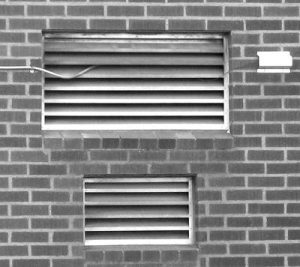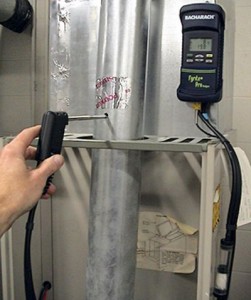Energy specialists have been using electronic combustion analyzers for decades. These analyzers measure the percent of oxygen in combustion gases. Oxygen is one of the reagents in the combustion process. If you find oxygen in the combustion gases that almost always means that the combustion process has excess combustion air. If there is 6% oxygen in the combustion gases, you can assume that an atmospheric combustion appliance has enough combustion air.
I don’t know why technicians would follow an obscure and difficult procedure like those in the National Fuel Gas Code to evaluate a building’s combustion air if they could just do a five-minute combustion test. My biggest disappointment about ACCA’s Quality Installation Standard is that combustion testing is optional. You could verify the steady-state efficiency, measure CO in the combustion gases, and verify whether existing combustion air from the building or existing openings is adequate in five minutes. Why would this essential test be optional?
I wonder whether anyone regularly follows the combustion-air-calculation procedures described in in the NFPA’s National Fuel Gas Code . Their are two multi-step calculation methods depending in NFPA 54 depending on whether a building has more or less than 0.40 air changes per hour. Of course you don’t have to measure air leakage so you make an assumption. There are too many assumptions in these flawed calculations to discuss here. I’ll spare you the details. These calculations and procedures are so obscure, the NFPA could insert offensive language or nursery rhymes into NFPA 54 and almost no one would notice.
Technicians cut large holes in thousands of buildings that don’t need supplemental combustion air. Why not test for oxygen during your installation or service call and decide whether the appliance needs more combustion air before drilling expensive holes through wood or masonry materials? The building may not require more combustion air and you can avoid damaging the building and creating a lot of unneeded air leakage.
Cutting a hole on a side of the building where strong winds blow parallel to the wall could actually depressurize the combustion zone. That happened to me once when we were weatherizing a church. I cut a 6 inch hole where the mechanical inspector drew a circle with his crayon. The hole faced out onto an East-West alley where the wind funneled through. The hole depressurized the combustion zone and pulled the flame right out of the heat exchanger. The pastor called me late at night to report a no-heat. The combustion air was coming down the chimney, the flame was burning out in front of the furnace like a blow torch, and the combustion gases were exiting through the combustion air tube. Frightening.
Then there’s the accuracy of the NFPA and IBC combustion-air calculations. In the August 2012 edition of Energy Engineering, Gary Krishman, boiler engineer for the NYC school district, questions the accuracy of the accepted methods. He claims that these calculations result in combustion-air vents that may be oversized by two times or more. We have combustion analyzers; we can measure the excess oxygen and the carbon monoxide. The NFPA’s armchair engineers seem unaware that combustion analyzers exist. It would be interesting to truth the NFPA and IBC requirements along with Gary’s recent calculations against the reality the combustion analyzer testing atmospheric boilers and furnaces.



Hear, hear.
The NFGC was written a long time ago, way before commodity-grade combustion analyzers were available to the general public. You are exactly right that a relatively quick test can tell a tech pretty quickly if there is enough excess air. Also, measuring the depressurization of the room with the appliance and the CO content of a supply register (for a forced-air system) also take little time and are good pieces of info to have.
Good comment Bob, thanks.